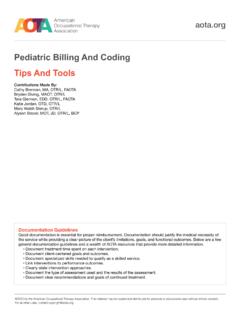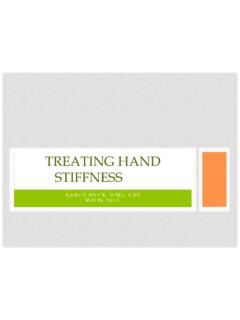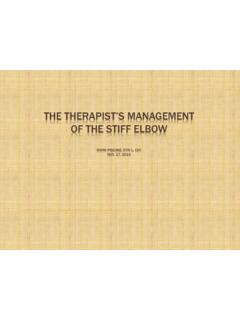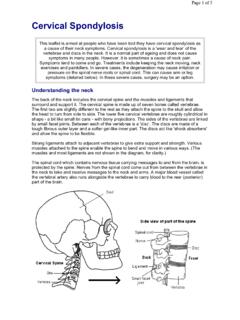Transcription of Splints and Casts: Indications and Methods
1 Splints and Casts: Indications and MethodsANNE S. BOYD, MD, University of Pittsburgh School of Medicine, Pittsburgh, PennsylvaniaHOLLY J. BENJAMIN, MD, University of Chicago, Chicago, IllinoisCHAD ASPLUND, MD, The Ohio State University College of Medicine, Columbus, Ohio Family physicians often make deci-sions about the use of Splints and casts in the management of muscu-loskeletal disorders. Because of this, they need to be familiar with Indications for application, proper technique, and the potential pitfalls of casting and splinting to optimize patient care when treating com-mon orthopedic and casts immobilize musculo- skeletal injuries while diminishing pain and promoting healing; however, they differ in their construction, Indications , benefits, and risks.
2 When determining whether to apply a splint or a cast, the physician must make an accurate diagnosis, as well as assess the stage, severity, and stability of the injury; the patient s functional requirements; and the risk of complications (Table 1).1,2 Because Splints are noncircumferential immobilizers and are, therefore, more for-giving, they allow for swelling in the acute phase. Splinting is useful for a variety of acute orthopedic conditions such as frac-tures, reduced joint dislocations, sprains, severe soft tissue injuries, and post-laceration repairs.
3 The purpose of splinting acutely is to immobilize and protect the injured extrem-ity, aid in healing, and lessen pain. Splinting during the later phases of injury or for chronic conditions will assist with healing, long-term pain control, and progression of physical function, and it will slow progres-sion of the pathologic ,4 Casting involves circumferential applica-tion of plaster or fiberglass to an extrem-ity. Casts provide superior immobilization, but are less forgiving and have higher com-plication rates. Therefore, they are usually reserved for complex and/or definitive frac-ture of any immobilizer comes with potential complications, including ischemia, heat injury, pressure sores, skin breakdown, infection, dermatitis, neuro-logic injury, and compartment syndrome.
4 These conditions can occur regardless of how long the device is To maximize benefits while minimizing complications, the use of casts and Splints is generally lim-ited to the short term. Excessive immobi-lization from continuous use of a cast or splint can lead to chronic pain, joint stiff-ness, muscle atrophy, or more severe com-plications, such as complex regional pain All patients who are placed in a splint or cast require careful monitoring to ensure proper of a wide variety of musculoskeletal conditions requires the use of a cast or splint.
5 Splints are noncircum-ferential immobilizers that accommodate swelling. This quality makes Splints ideal for the management of a variety of acute musculoskeletal conditions in which swelling is anticipated, such as acute fractures or sprains, or for initial stabilization of reduced, displaced, or unstable fractures before orthopedic intervention. Casts are circumferential immobilizers. Because of this, casts provide superior immobilization but are less forgiving, have higher complication rates, and are generally reserved for complex and/or definitive fracture management.
6 To maximize benefits while minimizing complications, the use of casts and Splints is generally limited to the short term. Excessive immobiliza-tion from continuous use of a cast or splint can lead to chronic pain, joint stiffness , muscle atrophy, or more severe complications ( , complex regional pain syndrome). All patients who are placed in a splint or cast require careful monitoring to ensure proper recovery. Selection of a specific cast or splint varies based on the area of the body being treated, and on the acuity and stability of the injury. Indications and accurate application techniques vary for each type of splint and cast commonly encountered in a primary care setting.
7 This article highlights the different types of Splints and casts that are used in various circumstances and how each is applied. (Am Fam Physician. 2009;80(5):491-499. Copyright 2009 American Academy of Family Physicians.)The online version of this article includes supple-mental content at http:// from the American Family Physician Web site at Copyright 2009 American Academy of Family Physicians. For the private, noncommercial use of one individual user of the Web site. All other rights reserved. Contact for copyright questions and/or permission and Casts492 American Family Physician Volume 80, Number 5 September 1, 2009 Cast/Splint Choice and ApplicationThis article highlights the different types of Splints and casts that are used in various circumstances and how each is applied.
8 In a previous article in American Family Physician, we discussed the principles and risks of casting and splint-ing, as well as proper techniques for safe and splinting both begin by placing the injured extremity in its position of function. Casting continues with application of stockinette, then circumferential application of two or three layers of cotton padding, and finally circumferential application of plaster or fiber-glass. In general, 2-inch padding is used for the hands , 2- to 4-inch padding for the upper extremities, 3-inch padding for the feet, and 4- to 6-inch padding for the lower may be accomplished in a variety of ways.
9 One option is to begin as if creating a cast and, with the extremity in its position of function, apply stockinette, then a layer of overlapping circumferential cotton pad-ding. The wet splint is then placed over the padding and molded to the contours of the extremity, and the stocki-nette and padding are folded back to create a smooth edge (Figure 1). The dried splint is secured in place by wrap-ping an elastic bandage in a distal to proximal direction. For an average-size adult, upper extremities should be splinted with six to 10 sheets of casting material, whereas lower extremities may require 12 to 15 acceptable alternative is to create a splint without the use of stockinette or circumferential padding.
10 Sev-eral layers of padding that are slightly wider and longer than the splint are applied directly to the smoothed, wet splint. Together they are molded to the extremity and secured with an elastic bandage (Figure 2). Prepackaged Splints consisting of fiberglass and padding wrapped in a Table 1. Comparison of Splints and CastsSplint/castConstruction IndicationsAdvantagesRisks/disadvantages SplintNoncircumferentialAcute and definitive treatment of select fracturesSoft tissue injuries (sprains, tendons)Acute management of injuries awaiting orthopedic interventionAllows for acute swellingDecreased risk of complicationsFaster and easier applicationCommercial Splints available and appropriate for select injuriesMay be static (preventing motion) or dynamic (functional.)

















